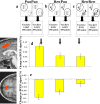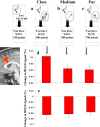Choosing the lesser of two evils, the better of two goods: specifying the roles of ventromedial prefrontal cortex and dorsal anterior cingulate in object choice
- PMID: 17079666
- PMCID: PMC6674525
- DOI: 10.1523/JNEUROSCI.1640-06.2006
Choosing the lesser of two evils, the better of two goods: specifying the roles of ventromedial prefrontal cortex and dorsal anterior cingulate in object choice
Abstract
The ventromedial prefrontal cortex (vmPFC) and dorsal anterior cingulate cortices (ACd) are considered important for reward-based decision making. However, work distinguishing their individual functional contributions has only begun. One aspect of decision making that has received little attention is that making the right choice often translates to making the better choice. Thus, response choice often occurs in situations where both options are desirable (e.g., choosing between mousse au chocolat or crème caramel cheesecake from a menu) or, alternatively, in situations where both options are undesirable. Moreover, response choice is easier when the reinforcements associated with the objects are far apart, rather than close together, in value. We used functional magnetic resonance imaging to delineate the functional roles of the vmPFC and ACd by investigating these two aspects of decision making: (1) decision form (i.e., choosing between two objects to gain the greater reward or the lesser punishment), and (2) between-object reinforcement distance (i.e., the difference in reinforcements associated with the two objects). Blood oxygen level-dependent (BOLD) responses within the ACd and vmPFC were both related to decision form but differentially. Whereas ACd showed greater responses when deciding between objects to gain the lesser punishment, vmPFC showed greater responses when deciding between objects to gain the greater reward. Moreover, vmPFC was sensitive to reinforcement expectations associated with both the chosen and the forgone choice. In contrast, BOLD responses within ACd, but not vmPFC, related to between-object reinforcement distance, increasing as the distance between the reinforcements of the two objects decreased. These data are interpreted with reference to models of ACd and vmPFC functioning.
Figures





Comment in
-
The best of a bad bunch: the ventromedial prefrontal cortex and dorsal anterior cingulate cortex in decision-making.J Neurosci. 2007 Jan 17;27(3):447-8. doi: 10.1523/jneurosci.4967-06.2007. J Neurosci. 2007. PMID: 17240549 Free PMC article. Review. No abstract available.
References
-
- Anderson AK, Christoff K, Stappen I, Panitz D, Ghahremani DG, Glover G, Gabrieli JD, Sobel N. Dissociated neural representations of intensity and valence in human olfaction. Nat Neurosci. 2003;6:196–202. - PubMed
-
- Blair RJ. The roles of orbital frontal cortex in the modulation of antisocial behavior. Brain Cogn. 2004;55:198–208. - PubMed
-
- Botvinick MM, Cohen JD, Carter CS. Conflict monitoring and anterior cingulate cortex: an update. Trends Cogn Sci. 2004;8:539–546. - PubMed
-
- Budhani S, Pine DS, Blair RJR. Ventrolateral prefrontal cortex and response reversal: inhibiting prepotent responses, representing punishment or activating alternative responses? NeuroImage. 2006 in press.
Publication types
MeSH terms
Grants and funding
LinkOut - more resources
Full Text Sources
